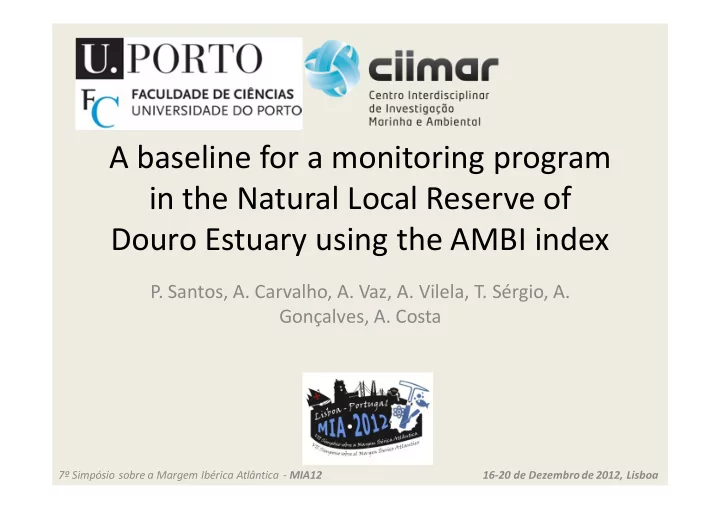

A baseline for a monitoring program in the Natural Local Reserve of Douro Estuary using the AMBI index P. Santos, A. Carvalho, A. Vaz, A. Vilela, T. Sérgio, A. Gonçalves, A. Costa 7º Simpósio sobre a Margem Ibérica Atlântica - MIA12 16-20 de Dezembro de 2012, Lisboa
Intro Contract between the Municipality of Vila Nova de Gaia and the Faculty of • Sciences, University of Porto entitled "Study and monitoring of vertebrates and invertebrates of Natural Local Reserve of Douro estuary” The conservation and operation of RNLED must be based on scientific knowledge • about the functioning of the ecosystem.
Natural Local Reserve of Douro Estuary Created in 2008 – 54ha of protected area • Main objective of the reserve – shelter and feeding area for migratory birds, some • of them a priority for conservation under the EU Birds Directive (79/409/EEC)
Aims Use the benthic community of RNLED to access the ecological quality of this system, • with the application the AMBI index Establish a baseline for future monitoring programs in the reserve • Create scientific knowledge to support conservation and management of the reserve •
Methods Fieldwork 11 sampling stations (3 sandy shore; 1 salt-marsh; 7 mud/sand estuarine zone) • 12 sampling months (June 2010 – May 2011) • Collect the superficial sediment layer using a core sampler (10cm diameter) • Samples fixed and stained with 4% formalin + Rose Bengal • Laboratory Identification and counting of invertebrates •
AZTI Marine Biotic Index (AMBI) Borja et al. (2000) Designed for the study of benthic EG I - Very sensitive species • macroinvertebrate communities, assessing Ecological Groups the ecological quality in coastal environments; Software that includes more than 6500 • EG V - Opportunistic species taxa (last updated May 2012); of 1st Order Assign to each species a particular • Ecological Group (EG) according to a gradient 7 - Heavily disturbed system of sensitivity to disturbances; AMBI Biotic Index Calculates the biotic index and graphically • represents all data; Proposes a classification of level of • disturbance of a coastal ecosystem by the representation of health of benthic macroinvertebrate community; 0 - Undisturbed system
63576 ind. in total of Results 264 samples in 12 months 32 taxa Biomass Abundance 2% 2% 1% 2% TUBIFICIDAE 6% Collembola 6% 25% TUBIFICIDAE Streblospio benedicti 16% COLLEMBOLA Corophium volutator 12% Cyathura carinata Streblospio benedicti 0% Hediste diversicolor 4% Corophium volutator Scrobiculria plana 15% 5% Cyathura carinata 62% Corbicula fluminea Hediste diversicolor 28% 12% Carcinus maenas Outros Outros Tubificidae 39529 ind. Hediste diversicolor 55,502 g Index Mean value Shannon-Wienner 0.598 Diversity Eequitability of Pielou 0.473
Results Sandy Shore Salt-marsh Mud/sand estuarine zone Habitats of Mean density ind./m 2 RNLED Sandy 22077 Shore Salt-marsh 1406 Mud /sand estuarine 33902 MDS analysis Similarity between data density of sampling stations zone
Results Assignment of ecological groups Sampling months • Ecological group V (opportunistic species and less sensitive to disturbances) was the most abundant in all sampling sites and in all months (>65%) • Due to high percentage of TUBIFICIDAE Sampling stations • Taxa “not assigned” (<3,6%) lower than (20%) recommended by Borja et al. (2004)
Results AMBI Biotic Index Sampling months • AMBI index range between 4 - 6 • Due to high percentage of taxa of Ecological Group V • AMBI index Indicates a system “Moderately disturbed” to “Heavily disturbed” Sampling stations
Results Spatialization of AMBI values – Application of GIS tools
Conclusions AMBI index classified the protected area as “Moderately disturbed” to “Heavily • disturbed” The value of Shannon diversity index (0.598) is lower than the value previously • recorded in Douro estuary (0.734) (Mucha et al. 2004) We established a baseline for future studies and monitoring programs on the • evolution of this reserve and on the evaluation of its management for conservation
Thanks for Your Attention 7º Simpósio sobre a Margem Ibérica Atlântica - MIA12 16-20 de Dezembro de 2012, Lisboa
Recommend
More recommend